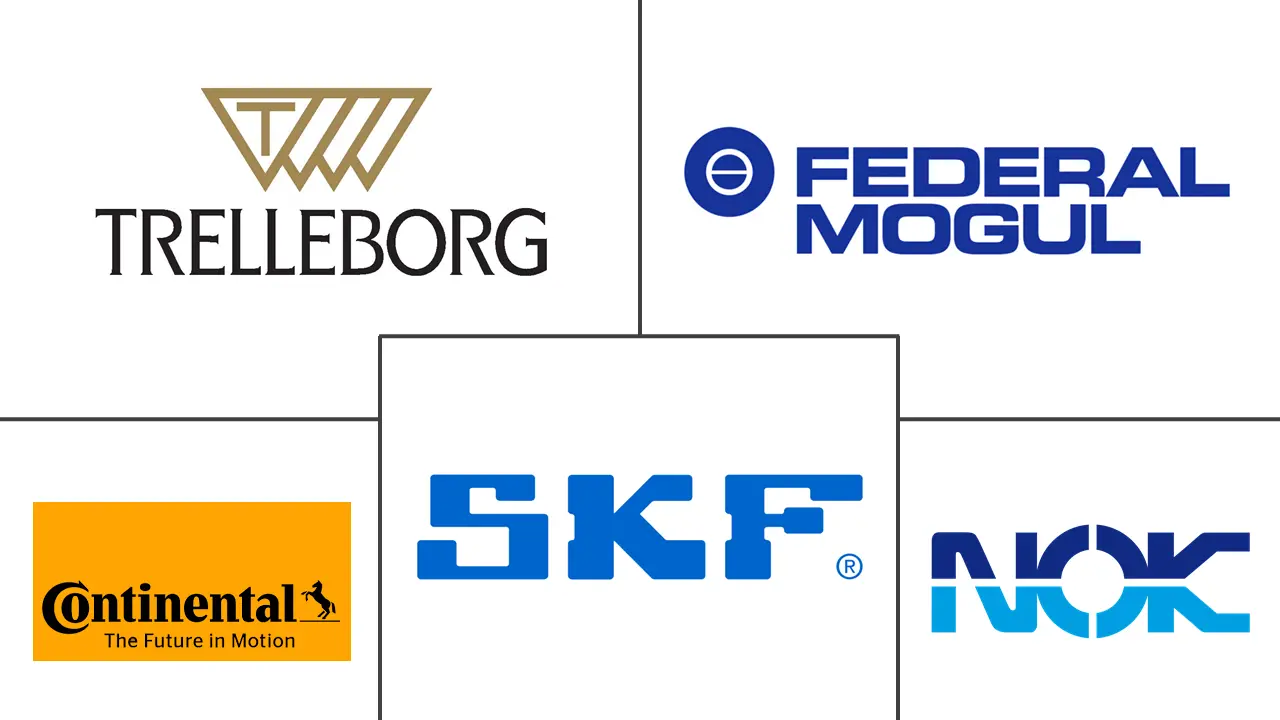Automotive Rubber Molded Components Market Size and Share
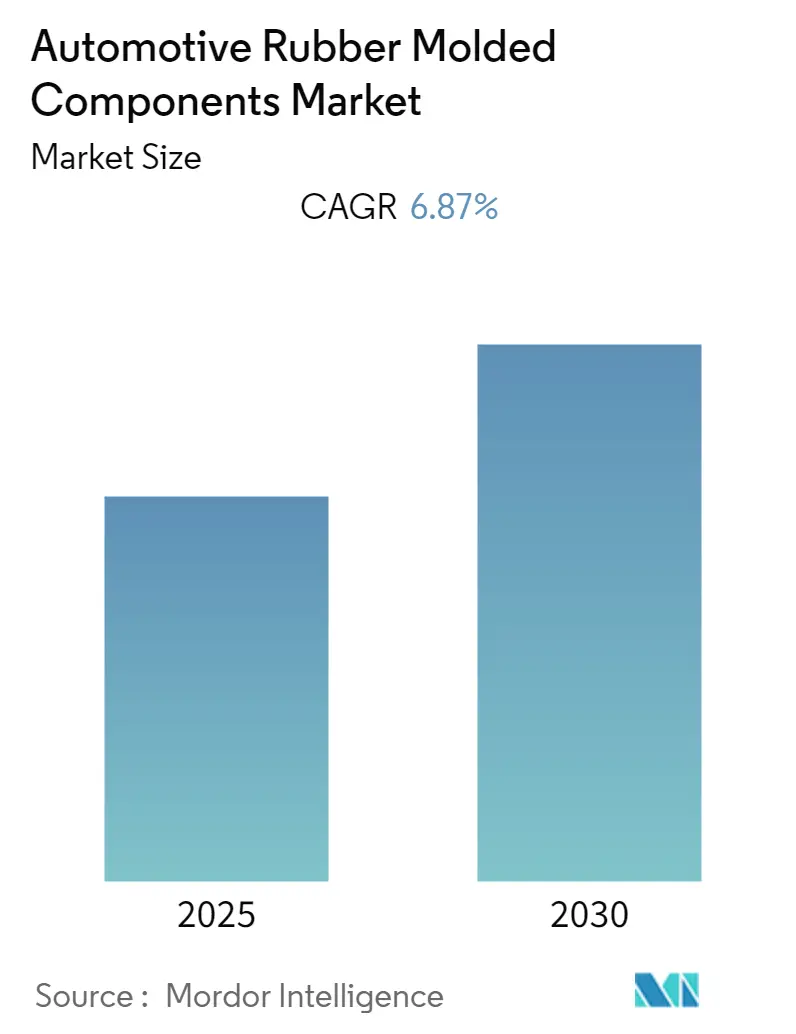
Automotive Rubber Molded Components Market Analysis by Mordor Intelligence
The Automotive Rubber Molded Components Market is expected to register a CAGR of 6.87% during the forecast period.
- The major players in the automobile industry are looking for various ways to reduce the overall weight of the vehicle. The reduced weight of the vehicle not only enhances the fuel efficiency of the vehicle but also reduces the pollutant emission from the exhaust and hence, complying with the stringent government norms and attract more demand. To meet the specific demand from OEMs, the sealing system manufacturers are benchmarking the present technology and the material used to make the new sealing systems, which is aimed to be lighter in weight, highly reliable, safe, and will possess lower production costs than conventional sealants.
- Advances in release agents, nowadays, are making rubber and its components more attractive to auto manufacturers. For hundreds of years, rubber has been used in the automotive industry. Rubber-molded products, which were formerly extracted from natural materials, are now being made from inexpensive and common synthetic polymers, owing to many factors, including weight, environmental, expense, and longevity concerns. These rubber-molded components can be molded into all shapes, sizes, and colors, for different use in the automotive industry. This is a major growth factor for the market studied.
- By utilizing renewable soy oil as a swap for 25% of the petroleum oil utilized in rubber, Ford succeeded in doubling the material's stretchability and diminishing the carbon discharges from its crude materials. The new formula can be utilized in car parts, like seals, gaskets, hoses, radiators, and floor mats. According to the International Rubber Study Group, the automotive sector holds more than 50% of the global rubber consumption, which exceeded 22 million metric ton in 2008. Owing to its benefits and applications in various processes, the use of rubber in car parts is further expected to rise during the forecast period.
Global Automotive Rubber Molded Components Market Trends and Insights
Ethylene Propylene Diene Monomer (EPDM) Segment To Exhibit A Significant Growth Rate During The Forecast Period
Ethylene propylene diene monomer (EPDM) is a type of synthetic rubber which has a lot of characteristics and features, such as weather resistance, vibration resistance, heat resistance, color stabilization, sealing property, tear resistance, durability, tensile strength (500 to 2500 PSI), etc. considered suitable for automotive applications. EPDM has a density of more than 2.00 g/cm3 and is the best for economical use. Lightweight materials like EPDM which lower pollution are a driving factor for the global automotive rubber-molded components market. The automotive industry is the largest customer for EPDM rubber. The need to reduce the vehicle weight to minimize vehicular emission is driving the growth of the market. The rising trend of electric vehicles and new energy vehicles is propelling the demand for EPDM rubber-molded components. EPDM has excellent electrical insulating properties. It has good resistance to ketones, ordinary diluted acids and alkalis, and excellent weather ability. It has excellent low temperature properties -60°F/-51°C and good high temperature resistance up to 350°F/177°C. The EPDM rubber is generally used for making weather seals and stripping, owing to its good adhesive characteristics with metal, wire and cable harness, window spacers, hydraulic brake systems, and seals for doors, windows, and trunks. The market for EPDM is expected to enjoy a healthy growth rate in the Asia-Pacific region, owing to the growth in electrification, stringent emission norms, growing demand for lightweight and commercial vehicles and availability of low-cost labor for automotive rubber component manufacturing in the region.
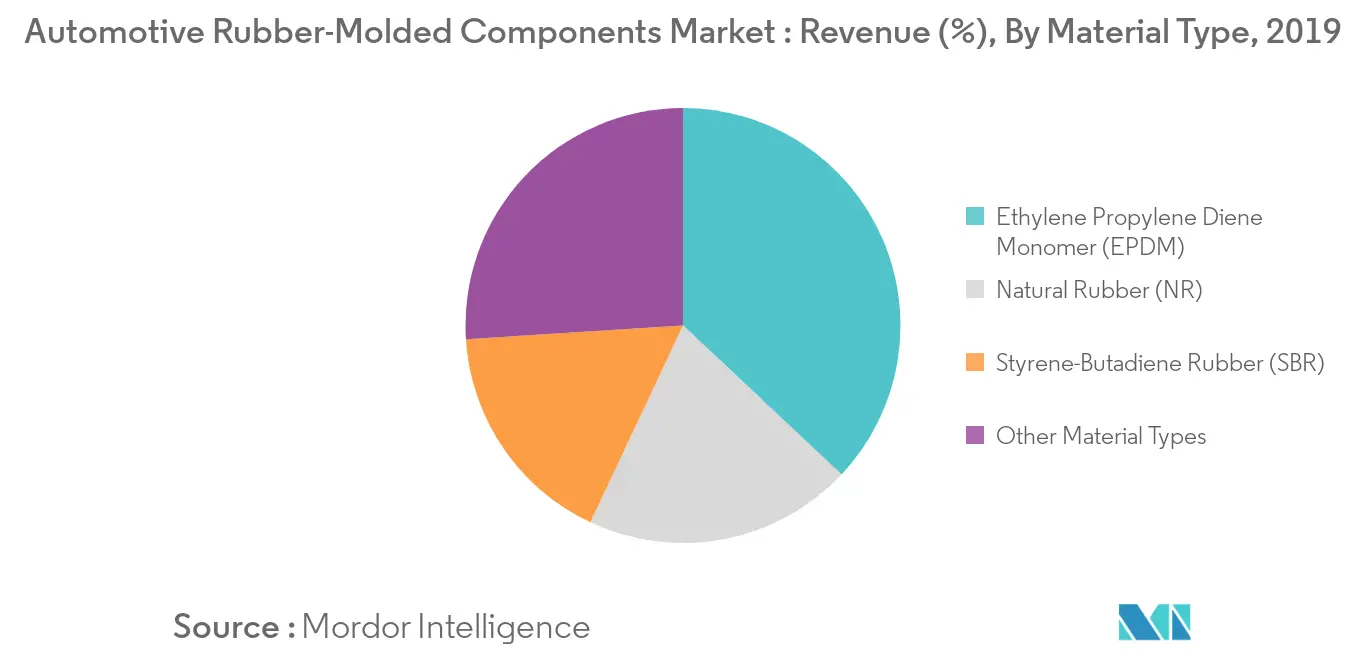
Asia-Pacific Is Leading The Market
China is one of the major producers of vehicles across the world. In 2019, China produced approximately 28% of the total vehicles in the world. At present, most of the vehicles produced in the country are IC engine vehicles. According to the China Association of Automobile Manufacturers, the total sales in the country fell by 8.2% in 2019 compared to the previous year. However, China's premium car market maintained stable growth in 2019. The luxury car market is concentrated and is dominated by Mercedes-Benz, Audi, and BMW. The Chinese manufacturers have accelerated the market development for hybrid and electric vehicles after the government's development plan that emphasized the need for new energy vehicles (electric, hybrid, and fuel-cell vehicles) in 2012. The Chinese government's policy on new energy to phase out all petrol and diesel cars. The country announced that by 2025, at least one-fifth of the vehicles on the roads would be electric-battery cars and plug-in hybrid cars. This will impact the market as the rubber molded components will phase out the application in electric vehicles used in IC engines.
The electric vehicle market in Japan has been experiencing growth. The demand for emission-free vehicles has been increasing, and the government has been investing heavily in this electric vehicle market. The Japanese government aims to transform all the new cars, sold in the country, to electric or hybrid vehicles, by 2050. The government has also set a target to reduce the emissions of carbon dioxide and other greenhouse gasses, by about 80% per vehicle, by 2050. This will impact the market as the rubber molded components have less application in electric vehicles as compared to IC engines.
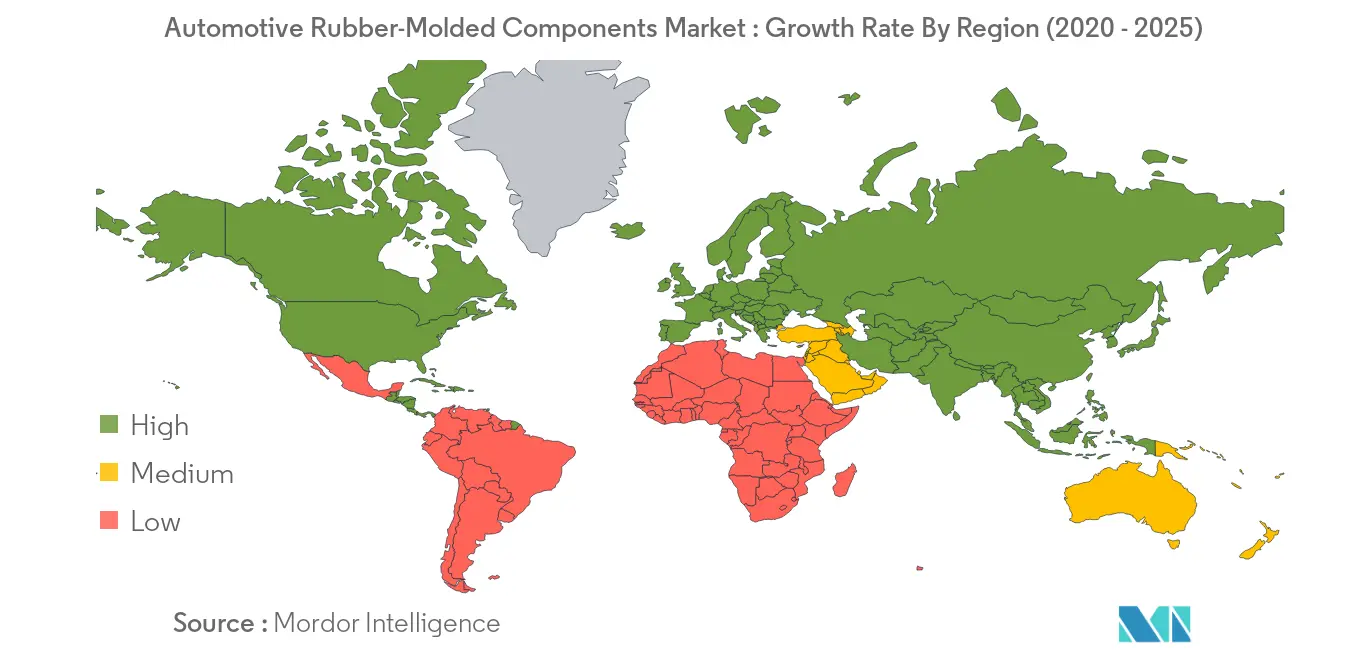
Competitive Landscape
The automotive rubber molded component market is moderately fragmented one and dominated by various players which include, Continental AG, DANA Holding Corporation, Hutchison SA, Trelleborg AB, Federal-Mogul Corporation, Freudenberg and Co. Kg, among others.
The companies are expanding their business by opening new plants. For instance -
- In March 2019, Hubner Manufacturing Corporation has invested USD 9.6 million to establish a new manufacturing facility in Dunlap, Tennessee.
- In September 2018, Zeon Corporation (Zeon) announced that it will establish a wholly owned subsidiary for the production and sales of acrylic rubber in Thailand. The new plant will be Zeon's third acrylic rubber plant after its Japanese and US plants. Demand for acrylic rubber is expected to increase in Asia.
Automotive Rubber Molded Components Industry Leaders
-
AB SKF
-
Continental AG
-
Federal-Mogul Corporation
-
NOK Corporation
-
Trelleborg AB
- *Disclaimer: Major Players sorted in no particular order
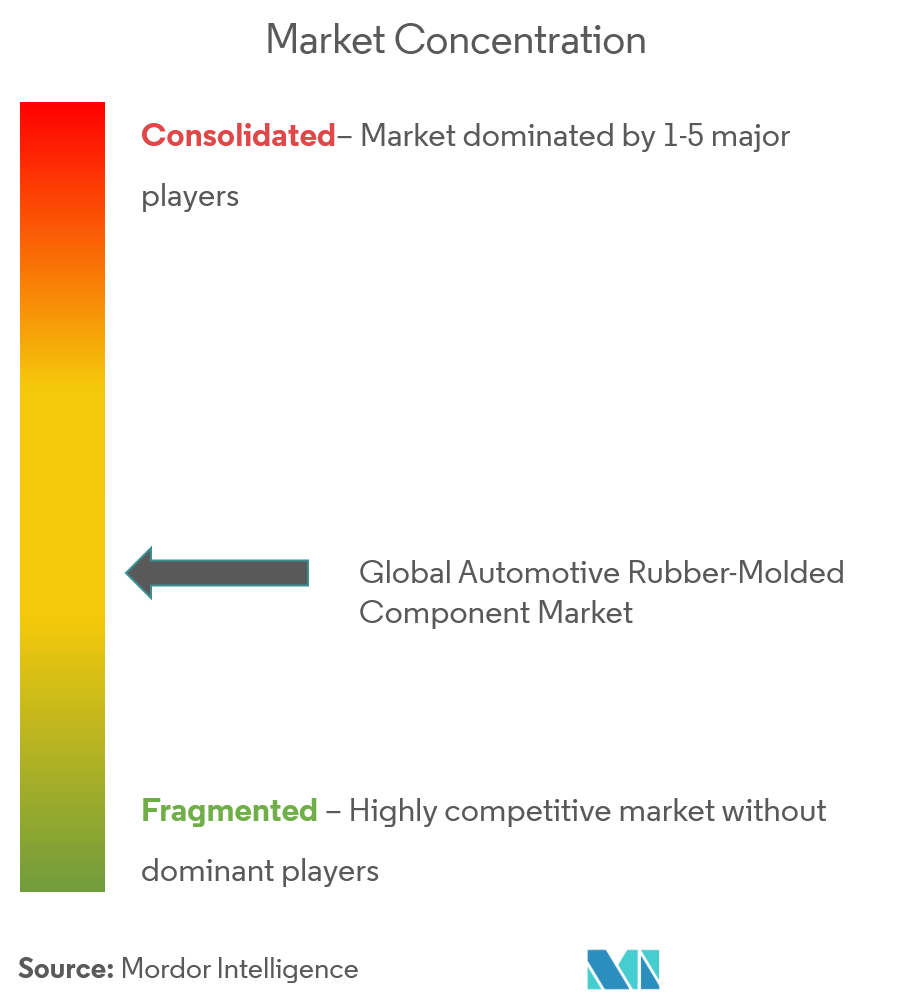
Global Automotive Rubber Molded Components Market Report Scope
The automotive rubber-molded component market covers the latest trends and technological development in the automotive rubber-molded component, demand of the material type, component type, vehicle type, geography and market share of major automotive rubber-molded component manufacturers across the world.
| Ethylene Propylene Diene Monomer (EPDM) |
| Natural Rubber (NR) |
| Styrene-butadiene Rubber (SBR) |
| Other Material Types |
| Seals |
| Gaskets |
| Hoses |
| Weather-strips |
| Other Component Types |
| Passenger Car |
| Commercial Vehicle |
| North America | United States |
| Canada | |
| Rest of North America | |
| Europe | Germany |
| United Kingdom | |
| France | |
| Rest of Europe | |
| Asia-Pacific | China |
| Japan | |
| India | |
| Rest of Asia-Pacific | |
| Rest of the World | South America |
| Middle East & Africa |
| By Material Type | Ethylene Propylene Diene Monomer (EPDM) | |
| Natural Rubber (NR) | ||
| Styrene-butadiene Rubber (SBR) | ||
| Other Material Types | ||
| By Component Type | Seals | |
| Gaskets | ||
| Hoses | ||
| Weather-strips | ||
| Other Component Types | ||
| By Vehicle Type | Passenger Car | |
| Commercial Vehicle | ||
| Geography | North America | United States |
| Canada | ||
| Rest of North America | ||
| Europe | Germany | |
| United Kingdom | ||
| France | ||
| Rest of Europe | ||
| Asia-Pacific | China | |
| Japan | ||
| India | ||
| Rest of Asia-Pacific | ||
| Rest of the World | South America | |
| Middle East & Africa | ||
Key Questions Answered in the Report
What is the current Automotive Rubber Molded Components Market size?
The Automotive Rubber Molded Components Market is projected to register a CAGR of 6.87% during the forecast period (2025-2030)
Who are the key players in Automotive Rubber Molded Components Market?
AB SKF, Continental AG, Federal-Mogul Corporation, NOK Corporation and Trelleborg AB are the major companies operating in the Automotive Rubber Molded Components Market.
Which is the fastest growing region in Automotive Rubber Molded Components Market?
Asia Pacific is estimated to grow at the highest CAGR over the forecast period (2025-2030).
Which region has the biggest share in Automotive Rubber Molded Components Market?
In 2025, the Asia Pacific accounts for the largest market share in Automotive Rubber Molded Components Market.
What years does this Automotive Rubber Molded Components Market cover?
The report covers the Automotive Rubber Molded Components Market historical market size for years: 2019, 2020, 2021, 2022, 2023 and 2024. The report also forecasts the Automotive Rubber Molded Components Market size for years: 2025, 2026, 2027, 2028, 2029 and 2030.
Page last updated on:
Automotive Rubber Molded Components Market Report
Statistics for the 2025 Automotive Rubber Molded Components market share, size and revenue growth rate, created by Mordor Intelligence™ Industry Reports. Automotive Rubber Molded Components analysis includes a market forecast outlook for 2025 to 2030 and historical overview. Get a sample of this industry analysis as a free report PDF download.
